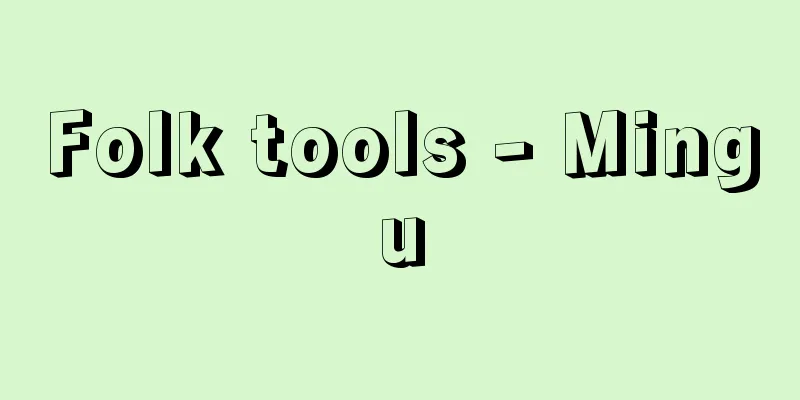Folk tools - Mingu

|
A term used in the study of Japanese culture, it is a general term for traditional tools and sculptures that are made or used daily by ordinary people (common people) out of necessity, and is an indispensable resource for studying the origins and transitions of Japanese life, and the structure and characteristics of Japan's underlying culture. The term was coined by Shibusawa Keizo, who presided over the Institute for Japanese Folk Culture (formerly known as the Attic Museum, now the Institute for Japanese Folk Culture at Kanagawa University), and was established between 1934 and 1935. Before Shibusawa coined the term "mingu," he called it "folk goods." Today, "mingu" is widely accepted in academic circles. [Naoyuki Ogawa] The field of folk toolsIn folklore studies, folk tools are used to refer to material culture in general as opposed to spiritual culture, and the specific content is broad, but since the term was established, coupled with the rapid changes in lifestyle since then, it is thought that a comprehensive reexamination of its definition and scope is necessary. Here, we will show the scope (concept) of folk tools from the "Outline of Survey on Folk Tools Collection" published by the Attic Museum in 1936. This book can be said to be the starting point of research on Japanese folk tools, and has had a major impact on subsequent research, becoming the basis for the current concept and classification of folk tools. It defines folk tools as "everyday tools technically created by our fellow countrymen for the needs of daily life," and classifies them into eight categories to show their scope. The gist of it is as follows: (1) Necessities related to food, clothing and shelter (2) Lighting equipment (lights, ignition devices, and some fuel): hornbeam pots, lighthouse boxes, lanterns, candlesticks, lanterns, lantern stands, paper lanterns, candles, rosin candles, tsukegi, tinder boxes, tinder bags, torches, tinder boxes, flint stones, flint sickles, etc. (3) Cooking utensils (including general kitchen utensils used mainly for cooking): pots, kettles, buckets, cutting boards, pestles, kneading bowls, knives, tofu-making machines, flour grinding tools, mortars, pestles, ladles, saltpots, trivets, sieves, cooking racks, pot scoops, etc. (4) Eating and drinking utensils, food, and luxury items (including general eating and drinking utensils, other tea utensils, and tobacco utensils) Wooden trays, box trays, tea holders, bowls, chopsticks, inro (seals), menpa (seals), wappu (tableware), carrying utensils, tea buckets, tea whisks, tea scoops, tea mortars, tobacco cutting tools, tobacco trays, etc. (5) Clothing (excluding footwear. Among general clothing, this includes formal wear, everyday wear, and work wear made from materials with regional characteristics. Also includes cold-weather, rain-proof and sun-protecting clothing). Materials in general include wisteria cloth, linen, cotton products, Mada fiber products, ramie, kudzu cloth, animal hides, reeds, palm, cattail, cattail, reed, rush, the outer bark of Asunaro, cypress, bamboo, paper, etc. Products include wisteria cloth clothing, deerskin clothing, Madan cloth monkey pants, karusan, dog skin vests and breastplates, straw gloves, gamahabaki, donza, sashiori, shin guards, heel guards, instep covers, hand coverings, collar guards, furoshiki, hand towels, sanshaku, ute, general work clothes, various hoods, belly wraps, aprons, etc. Umbrellas, hats, straw raincoats, loincloths, waist guards, loincloths, shoulder raincoats, bandori, etc. (6) Footwear (made from various materials): various types of geta, straw sandals, clogs with nails, bamboo geta, beach geta, sandals, footwear, straw sandals, leather sandals, snow shoes (made of wood or iron), large feet, rice field geta, etc. (7) Personal Accessories: Combs, hairpins, hair ties, bamboo sticks, other hairdressing tools, bags, tattoo tools, etc. (8) Childbirth and childcare equipment: Gifts, lucky charms, or local furnishings related to childbirth. Childcare-related items include baby baskets such as tsugura, isume, isa, and shinta. (9) Hygiene and health equipment (including equipment and materials necessary for folk remedies): Tooth blackening equipment, discarded sticks (Japanese knotweed trunks, bamboo spatulas, seaweed), heated stones, Swertia jasmine, Coptis jasmine, honey locust fruits, etc. [2] Occupation-related matters (2) Woodcutter's equipment (items related to woodcutter's work, excluding transportation equipment): Sickles, various hatchets, saws, axes, hatchet sheaths, whetstone bags, lunch bags, etc. (3) Hunting equipment (excluding modern-day firearms. Firearms up to so-called matchlock guns and others): Gunpowder cases (made by each hunter, such as inro-style, bamboo tubes, Nagato-crafted, and horn-made cases), hunting clothes, fire links, fire link cases, fire case, muzzle medicine cases, bullet-making machines, machetes, deer whistles, bird whistles, whistles, hand guns, traps, etc. (4) Fishing equipment (fishing equipment used in the sea, lakes, rivers, etc., including equipment for collecting seaweed): fishing nets, various fishing tackle, various nets, harpoons, sickles, spears, isokane, akatori, isogi, etc. (5) Items relating to spinning and dyeing: looms, ground looms, matting looms, spinning wheels, cotton ginning machines, cotton beating tools, frame stands, hemp barrels, thread bobbins, various reeds, shuttles, striped curtains, twisting mats, etc. Materials include Mada, hemp, wisteria, indigo, gardenia, mud, purple, Hibiscus, etc. Products include Wisteria cloth, Kozo cloth, hemp cloth, Mada cloth, cotton, charcoal bags, cats, straw mats, mats, blinds, tatami coverings, etc. (6) Livestock equipment (including Hakuraku-related equipment): Reins, bits, belly straps for horses and cattle, various types of hay buckets, bells, nose rings, scissors for cutting manes, Raku brands, nail clippers, nose blocks, mouth guards, shoes for horses and cattle, hitches, etc. (7) Tools of trade (items related to trade and markets, including instruments for measuring weights and measures, calculating instruments, etc.) Abacus, various types of measuring instruments, purses, money boxes, etc. (8) Other: Tools used by lacquer scrapers, camphor collectors, gold panners, woodworkers, side cutters, cedar peelers, rock mushroom pickers, roofers, salt marshals, masons, carpenters, blacksmiths, etc. [3] Items related to communication and transport (2) Travel equipment: a rag bag, straw sandals, white robes, a loincloth, a kongo staff, etc. (3) Notification devices: clappers, conch shells, wooden boards, baton bells, half-bells, baton bells, flags, signal fire devices, letter boxes, etc. [4] Items related to group living (including disaster prevention equipment, equipment for youth dormitories, land division equipment, communal work equipment, etc.): bowls, shared nets, cars, etc. [5] Ceremonies (2) Marriage (gifts, auspicious items, or furnishings with local characteristics): Boats, boxes for carrying gifts, cotton hats, tools for blackening teeth, sake for finishing the ceremony, etc. (3) Yakuyoke (tools used to ward off evil spirits or ward off bad luck). (4) New Year celebrations (Toshiiwai): A fire-blowfish, a kimono with a woven cloth, hemp leaf loincloths, red chanchanko (kimono with a red lining), a hat, etc. (5) Funerals and anniversaries (folk implements with particular regional characteristics): footwear, head coverings, gifts, water stupas, etc. [6] Things related to faith and rituals (2) Offerings (Heihaku, votive offerings): Heihaku, kezurikake, yorishiro, Bonten, lanterns, decorations for the Dosojin festival, ropes, soot sweepers, brushwood, stones, banners, cocoon balls, etc. (3) Ritual offerings and offerings: Ritual offerings such as salt baskets, purification vessels, Ebisu straw plates, omikisuzu (sacred sake spouts), water-based rice cakes, etc. (4) Musical Instruments: flutes, drums, bells, Kagura bells, wooden horns, sasara (bamboo combs), gongs, bells, bamboo clappers, and similar instruments. (5) Masks (main materials and styles are woodcarving, painted woodcarving, painted wood, birch bark, gourd, clay mold, papier-mâché, etc., including auxiliary devices): Demons, Kannon, Hannya, Hinomizuno, monkeys, crabs, Namahage, Okame, Hyottoko, Jo, Tengu, lions, dragons, foxes, etc. (6) Jugu: Folk tools, animals, plants, and other things that are endowed with magical properties. (7) Divination tools: divination sticks, walking sticks, counting sticks, divining sticks, lottery boxes, etc. (8) Prayer items: stone bowls, costumes of mountain gods, pillows, stonefish, votive bags, firewood, etc. [7] Equipment related to recreational games, gambling, and competitions. [8] Toys and lucky charms: Handmade toys (gangu) that are not merchandise. The outline of folk tools is given in the "Outline of the Survey of Folk Implements," but the designation criteria for Important Folk Materials (now Important Tangible Folk Cultural Properties and Important Intangible Folk Cultural Properties) announced by the Committee for the Protection of Cultural Properties in 1954 (Showa 29) stipulate the following areas and classifications: (1) items used for food, clothing, and shelter, (2) items used for production and livelihood, (3) items used for transportation, shipping, and communication, (4) items used for trade, (5) items used in social life, (6) items used for faith, (7) items used for folk knowledge, (8) items used for folk performing arts, entertainment, games, and hobbies, (9) items used in the course of human life, and (10) items used for annual events. [Naoyuki Ogawa] Research objectives and methodsFolk tools are found in all aspects of human life, and are basically things that have been made or used repeatedly by ordinary people throughout history for practical purposes in the natural environment and social relationships of each region, and are not highly artistic or rare items made by specific people. The current shapes and structures of folk tools have been created through the accumulation of people's life experiences, and the manufacturing techniques and usage methods have become stereotyped ideas (culture) and have been passed down with a common understanding. In other words, folk tools are practical items that are discarded when no longer needed, but they can be seen as one of the cultural products of a certain society, and one of the aims of folk tool research is to find the structure and characteristics that underlie Japanese culture from this. The attribute of folk tools as a stereotyped cultural tradition is based on the characteristics that Japanese folk tools are often made from plant-based materials that are easily rotten or damaged, and that items related to rituals, beliefs, and events are originally made repeatedly at regular intervals, as can be seen from the specific examples in the "Outline of the Survey of Folk Tool Collection." Although folk tools have the above attributes, they almost always undergo change and transition. For example, if you look at the examples in the "Outline of the Survey of Folk Tools Collection," you will notice that many of them are no longer used in modern life, or that their materials and structures have changed significantly since then. In particular, the lifestyles, production, and livelihoods of Japanese people have changed significantly since the Second World War, and it can be said that the tools used in daily life have undergone a qualitative transformation from before. The folk tools in the "Outline of the Survey of Folk Tools Collection" are no longer "familiar" to us, and the specific examples shown can be seen as folk tools from the modern era or from the modern era to the present, historically speaking. In other words, if we look at folk tools throughout the ages, there are changes, transitions, and transformations, and one research topic is to clarify these changes along with the various folk tools that are used at the same time. Furthermore, from this, the objective of searching for the laws of the emergence, succession, and variation of folk tools is born. This type of research makes it possible to consider the various artifacts that archaeologists deal with as folk tools (excavated folk tools) from each era, and the images of everyday life depicted in picture scrolls and other such documents are important sources for learning about the shape, structure, and usage of folk tools from the past. Although the subject of folk tool research is contemporary society, it goes without saying that the historical value of each folk tool is important. As mentioned above, modern-day tools have changed dramatically, and there is a movement to distinguish and study them using new concepts such as potential folk tools, basic folk tools, traditional folk tools, new folk tools, self-sufficient folk tools, and circulated folk tools. This poses a methodological challenge for current folk tool research, which is how to conduct research that responds to changes in research subjects and materials. The basis of the method of studying folk tools is the collection and recording of folk tools. As lifestyles change dramatically and traditional tools are lost, the role of facilities and institutions that collect and preserve folk tools is important. Furthermore, unlike archaeological remains and paintings, the name, use, production method, acquisition method, distribution, origin, and material of folk tools are often known, so recording these and illustrating the folk tools are essential information for research. Films and photographs also play an important role in recording, and in some cases non-destructive analysis using X-rays and other methods may be necessary. When documenting folk tools in this way, it is important to note that a folk tool is not used by itself, but is always accompanied by related tools and auxiliary tools, and these must also be collected and recorded. Methods for studying folk tools vary depending on the issue and purpose, and there are also unexplored aspects, but the basic traditional methods include capturing the same type of folk tool and comparing it in various places, and capturing all the folk tools within a certain area, such as one region, one village, or one house. The former is a diachronic method that makes it possible to clarify the transition of folk tools, while the latter is a synchronic method that allows us to consider the overall composition of tools and the characteristics of lifestyles, and can also be called folk tool research. Of course, these two methods are mutually complementary. [Naoyuki Ogawa] Research HistoryResearch on folk implements (material culture) in Japan began in the Meiji era under the names of anthropology and ethnology, and in the Taisho era it was also carried out in the journal Local Studies (1913-1934), but full-scale research did not begin until the Showa era, when the Attic Museum was founded in the Shibusawa residence by Shibusawa Keizo and others in 1921 (Taisho 10). In 1930 (Showa 5), Attic produced a guide for collections, calling for the collection of folk implements, and from around 1935, the group began to carry out research in various regions, producing many results, including the publication of Folk Implement Questions and Answers (1937). Research there was sadly interrupted during the Second World War, but on the other hand, the 13,000 or so folk implements collected by "Attic" were donated to the Japanese Society of Ethnology in 1937 (later donated to the Ministry of Education's Archives, and now transferred to the National Museum of Ethnology, Ministry of Education, Culture, Sports, Science and Technology), and folk implement research was carried out mainly at the Ethnology Museum attached to the Japanese Society of Ethnology. The Attic Museum was renamed the Japanese Folk Culture Research Institute in 1942, and became a foundation in 1950 (Showa 25). After Shibusawa's death, the museum published five volumes of "Illustrated Guide to the Life of the Japanese Folk through Picture Scrolls" between 1965 and 1968, once again becoming a base for folk implement research. In 1968, the institute began publishing "Mingu Monthly," which attracted many researchers, and in 1974 a folk implement research course was opened, and the Japanese Folk Implement Society was founded the following year in 1975. Currently, research is being conducted by the Japanese Society for Folk Tools, the National Museum of Ethnology, the National Museum of Japanese History, museums and archives of various local governments, the Kanagawa University Japanese Folk Culture Research Institute, which was established by inviting the Japanese Folk Culture Research Institute, and folk tool research groups around the country. With the establishment of the society, folk tool studies have begun to be advocated as a new method of material culture research. [Naoyuki Ogawa] "Japanese Folk Tools," edited by the Japanese Folk Culture Research Institute (1958, Kadokawa Shoten)" ▽ "Introduction to Folk Tools, written by Miyamoto Kataro (1969, Keiyusha)" ▽ "Japanese Folk Tools, written by Isogai Isamu (1971, Iwasaki Bijutsusha)" ▽ "Collection of Materials on the Life of the Japanese Folk," edited by the Japanese Folk Culture Research Institute, 24 volumes (1972-1973, Sanichi Shobo)" ▽ "Continuation of Japanese Folk Tools, written by Isogai Isamu (1973, Iwasaki Bijutsusha)" ▽ "Proposal for the Study of Folk Tools, written by Miyamoto Tsuneichi (1979, Miraisha)" ▽ "Guide to Folk Cultural Properties - For Research, Collection, Preservation, and Utilization," edited by the Folk Cultural Properties Research Group of the Agency for Cultural Affairs (1979, Daiichi Hoki Publishing)" ▽ "Japanese Folk Tools, written by Nakamura Takao (1981, Kobundo)" [References] | | | |Source: Shogakukan Encyclopedia Nipponica About Encyclopedia Nipponica Information | Legend |
|
日本文化研究上の術語の一つで、一般庶民(常民)が日常、その生活の必要から製作あるいは使用している伝承的な器具・造形物の総称で、日本人の生活の成り立ちや変遷、日本の基層文化の構造や特質を研究するうえで欠くことのできない資料である。この語の創唱者は、日本常民文化研究所(旧称アチック・ミューゼアム。現、神奈川大学日本常民文化研究所)を主宰した渋沢敬三で、1934年(昭和9)から35年の間に確定された。渋沢は「民具」を定立する以前は、これを「民俗品」といった。今日では「民具」が学界で広く認められている。 [小川直之] 民具の領域民具は、民俗学における精神文化に対する物質文化全般をさす語としても使われ、具体的内容は広範にわたっているが、「民具」が定立されて以降、当時からの生活様式の急激な変化などとも相まって、その定義・領域など全体的な再検討が必要と考えられる。ここでは、1936年にアチック・ミューゼアムから刊行された『民具蒐集(しゅうしゅう)調査要目』から民具の領域(概念)を示しておく。この書は日本の民具研究の出発点ともいえ、その後の研究に大きな影響を及ぼし、現在の民具の概念・分類の基礎となるものである。民具は「我々の同胞が日常生活の必要から技術的に作り出した身辺卑近の道具」であると定義し、8項目に大分類してその領域を示している。大要は次のようである。 〔1〕衣食住に関するもの (2)灯火用具(灯火器および発火器、燃料の一部も加える) シデ鉢、灯台箱、行灯(あんどん)、燭台(しょくだい)、カンテラ、カンテラ台、提灯(ちょうちん)、蝋燭(ろうそく)、松脂(まつやに)蝋燭、附木(つけぎ)、火打箱、火打袋、松明(たいまつ)、火口箱(ほくちばこ)、火打石、火打鎌(がま)など。 (3)調理用具(一般台所用具中、主として調理に使用する道具を含む) 鍋(なべ)、釜(かま)、桶(おけ)、俎(まないた)、摺子木(すりこぎ)、練鉢(ねりばち)、包丁、豆腐製造器、粉挽(こなひき)道具、臼(うす)、杵(きね)、柄杓(ひしゃく)、塩壺(しおつぼ)、鍋敷、笊(ざる)、テッキ、鍋取りなど。 (4)飲食用具、食料および嗜好(しこう)品(一般飲食器具、その他茶道具、煙草道具を含む) 木地膳、箱膳、盆、茶通(ちゃつう)、椀(わん)、箸(はし)、印籠(いんろう)、メンパ、ワッパ、行器(ほかい)、茶桶、茶筅(ちゃせん)、茶杓、茶臼、煙草切道具、煙草盆など。 (5)服物(履き物を除く。一般服物のうち、地方的特色のある様式材料による晴着、常着(つねぎ)、労働着を含む。そのほか防寒、防雨、日覆(ひおい)の類も含む) 総括して材料には、藤布(ふじぬの)、麻布、綿製品、マダの繊維製品、カラムシ、葛楮布(くずふ)、獣皮、篠(しの)、棕櫚(しゅろ)、蒲葵(くば)、蒲(がま)、菅(すげ)、藺(い)、アスナロの外皮、檜(ひ)、竹、紙など。製品としては、藤布の裁着(たっつけ)、鹿(しか)皮の裁着、マダ布の猿袴(さるばかま)、カルサン、犬の皮の胴着・胸当、藁(わら)の手袋、蒲脛巾(がまはばき)、ドンザ、裂織(さきおり)、脛巾、踵当(かかとあて)、甲掛(こうがけ)、手覆(ておい)、襟当(えりあて)、風呂敷(ふろしき)、手拭(てぬぐい)、三尺、ユテ、一般の仕事着、各種頭巾、腹掛、前掛など。傘、笠(かさ)、蓑(みの)、腰当、腰蓑、肩蓑、バンドリの類など。 (6)履き物(材料には各種ある) 下駄各種、藁沓(わらぐつ)、爪掛(つまがけ)類、竹下駄、浜下駄、草履(ぞうり)、足半(あしなか)、草鞋(わらじ)、皮沓(かわぐつ)、カンジキ(木製・鉄製)、大足(おおあし)、田下駄など。 (7)装身具 櫛(くし)、笄(こうがい)、元結(もとゆい)、竹長(たけなが)、そのほか結髪用具、袋物、文身(いれずみ)道具など。 (8)出産育児用具 出産に関しては祝品、縁起物または地方的特色のある調度品類。育児関係のものではツグラ、イズメ、イサ、シンタなどの嬰児籠(えじこ)の類。 (9)衛生保健用具(これには民間療法に必要な用具および材料を含む) お歯黒道具、捨木(すてぎ)(イタドリの幹、竹へら、藻)、温石(おんじゃく)、センブリ、オウレン、サイカチの実など。 〔2〕生業に関するもの (2)山樵(さんしょう)用具(山樵に関するもののうち、運搬関係の用具は除く) 鎌、鉈(なた)の各種、鋸(のこぎり)、斧(おの)、鉈の鞘(さや)、砥石(といし)袋、弁当袋など。 (3)狩猟用具(現在の鉄砲具は除外する。いわゆる火縄銃までの銃器その他) 烟硝(えんしょう)入れ(印籠(いんろう)式、竹筒、長門(ながと)細工、角(つの)製など狩人(かりゅうど)各自の製作によるもの)、狩着、火縄、火縄入れ、火子入れ、口薬(くちぐすり)入れ、弾丸製造器、山刀(やまがたな)、鹿(しか)笛、鳥笛、呼子(よびこ)笛、手鎗(てやり)、ワナなど。 (4)漁労用具(海・湖・川などに使用される漁労用具で、海藻採取に関するものも含む) 筌(うけ)、各種の釣り具、各種の網、銛(もり)、鎌、ヤス、磯(いそ)カネ、アカトリ、磯着(いそぎ)など。 (5)紡織色染に関するもの 機(はた)、地機(じばた)、莚機(むしろばた)、紡車(つむぎぐるま)、綿繰(わたく)り機、綿打具、枠の台、苧績桶(おぼけ)、糸管(いとくだ)、筬(おさ)の各種、梭(ひ)、縞帳(しまちょう)、撚(より)コなど。材料としては、マダ、麻、藤、藍(あい)、クチナシ、泥、紫、木槿(むくげ)など。製品としては、藤布、楮布(こうぞぬの)、麻布、マダ布、木綿、炭俵、ネコ、茣蓙(ござ)、莚(むしろ)、簾(すだれ)、畳表など。 (6)畜産用具(伯楽(はくらく)関係も含む) 手綱(たづな)、轡(くつわ)、牛馬腹掛、秣桶(まぐさおけ)の各種、鈴、鼻ホガシ、たてがみを切る鋏(はさみ)、ラク印、爪切り道具、鼻木、口(くち)モッコ、牛馬の沓(くつ)、面繋(おもがい)など。 (7)交易用具(交易、市(いち)に関係あるもので、度量衡具、計算具等も含む) そろばん、各種の桝(ます)、財布、銭箱など。 (8)その他 漆掻(うるしか)き、樟脳採(しょうのうと)り、砂金採り、木地師、側師(がわし)、皮剥(かわはぎ)(杉)、岩茸(いわたけ)採り、屋根葺(ふき)師、塩浜、石工、大工、鍛冶屋(かじや)などの使用する用具など。 〔3〕通信運搬に関するもの (2)行旅具 ヌサ袋、福草鞋(わらじ)、白衣、胴巻、金剛杖など。 (3)報知具 拍子木、法螺(ほら)貝、板木(ばんぎ)、采(ざい)、半鐘、采配(さいはい)、旗、のろし具、文箱(ふばこ)など。 〔4〕団体生活に関するもの(災害予防具、若者宿の道具、地割用具、共同労働具などを含む) 堂椀(どうわん)、共同使用の網、車など。 〔5〕儀礼に関するもの (2)婚姻(祝い物、縁起物または地方的特色のある調度品) フネ、継箱(つぎばこ)、綿帽子、お歯黒道具、〆(しめ)酒の類など。 (3)厄除(やくよけ)(厄除、厄払いに関係ある道具)。 (4)年祝(としいわい) 火吹竹、フクベの着物、麻の葉の褌、赤色のチャンチャンコ、帽子など。 (5)葬式、年忌(とくに地方的特色のある民具) 足半(あしなか)、被物(かぶりもの)、配物(くばりもの)、水塔婆(みずとうば)の類など。 〔6〕信仰・行事に関するもの (2)幣帛(へいはく)類 幣帛、削り掛け、依代(よりしろ)、梵天(ぼんてん)、万灯の類。道祖神祭の飾り、注連縄(しめなわ)の類。煤掃男(すすはきおとこ)、道柴(みちしば)の類。石、幟(のぼり)、繭玉など。 (3)祭供品および供物 塩手籠(しおてご)、清め御器(ごき)、エビスの藁皿、オミキスズ(神酒の口)などの祭供品、水の餅(もち)など。 (4)楽器 笛、太鼓、鈴、神楽(かぐら)鈴、編木(びんざさら)、簓(ささら)、鉦(かね)、鰐口(わにぐち)、四ツ竹、拍子木の類。 (5)仮面(材料・様式として木彫、木彫彩色、木地彩色、樺(かば)皮、瓢(ひさご)、土型、張子(はりこ)などがおもなもので、補助具も含む) 鬼神、観音、般若(はんにゃ)、日能水能(ひのうみずのう)、猿、蟹(かに)、なまはげ、オカメ、ヒョットコ、尉(じょう)、天狗、獅子(しし)、龍(たつ)、狐(きつね)など。 (6)呪具(じゅぐ) 呪性を帯びらせる民具類、動植物その他。 (7)卜具(ぼくぐ) 粥杖(かゆづえ)、杖、算木(さんぎ)、筮竹(ぜいちく)、籤箱(くじばこ)など。 (8)祈願品 石椀、山の神への扮装(ふんそう)、枕(まくら)、オコゼ、奉納苞(ほうのうづと)、薪(まき)など。 〔7〕娯楽遊技に関するもの娯楽遊戯、賭事(かけごと)、競技に関する器具。 〔8〕玩具・縁起物手製の玩具(がんぐ)で商品ではないもの。 『民具蒐集調査要目』では民具の概要をこのように示しているが、1954年(昭和29)に文化財保護委員会が告示した重要民俗資料(現在は重要有形民俗文化財、重要無形民俗文化財となっている)の指定基準では、その領域・分類を次のようにしている。(1)衣食住に用いられるもの、(2)生産・生業に用いられるもの、(3)交通・運輸・通信に用いられるもの、(4)交易に用いられるもの、(5)社会生活に用いられるもの、(6)信仰に用いられるもの、(7)民俗知識に関して用いられるもの、(8)民俗芸能・娯楽・遊戯・嗜好に用いられるもの、(9)人の一生に関して用いられるもの、(10)年中行事に用いられるもの。 [小川直之] 研究目的と方法民具はこのように人間生活全般にわたっており、基本的にはいずれも一般庶民が長い歴史を通じ、各地域の自然環境や社会関係のなかで実用目的をもって製作ないし使用が繰り返されてきたもので、特定の人々によってつくられた芸術性の高いものとか希少なものではない。民具の現在ある形や構造は人々の生活体験の累積のなかでつくられてきたものであり、そこには製作技術、使用法などが定型的な観念(文化)となって共通の理解がされて伝承されているのである。つまり、民具というのは実用品で、不用となれば廃棄されるのであるが、これは一定の社会における文化的産物の一つとしてとらえることができるのであり、ここから日本文化の基層にある構造や特質をみいだそうというのが民具研究の一つの目的である。ここでいう民具のもつ定型的文化の伝承という属性は、『民具蒐集調査要目』の具体例でもわかるように、日本の民具は腐敗・破損しやすい植物性のものでつくられたものが多いとか、儀礼・信仰・行事に関するものは本来、一定の周期で繰り返しつくられていくものだという特質に基づくといえるのである。 民具は以上のような属性をもつ反面、これにはかならずといっていいほど、変化・変遷がある。たとえば『民具蒐集調査要目』に例示されているものをみると、現代生活のなかではすでに使われてないもの、あるいは当時とその材質・構造などが大きく変わったものが多いのに気づくと思う。とくに第二次世界大戦以後は日本人の生活様式、生産・生業形態などが大きく変わり、生活用具はそれ以前と質的な変容をしているともいいうる。もはや『民具蒐集調査要目』の民具は、現在では「身近卑近」のものではなくなっているのであり、これに示された具体例は、歴史的にいえば近代あるいは近代から現代にかけての民具とみることも可能である。つまり、民具は通時代的にみていくならば、そこには変化・変遷あるいは変容があり、これを同時に使われる諸民具とともに明らかにすることが一つの研究課題となるのである。さらにここから、民具の発生、継承、変異の法則を求めていくという目的も生まれてくる。こうした研究では、考古学が扱う諸遺物もそれぞれの時代の民具(出土民具)と考えることが可能となるし、絵巻物類などに描かれた庶民生活の姿は過去の民具の形・構造・使用法を知る重要な資料となってくる。民具研究の対象はあくまで現代社会にあるのだが、民具それぞれがもつ歴史性は重要な点であることはいうまでもない。なお、現在の生活用具は前記のように大きく変貌(へんぼう)しており、これを潜在民具、基本民具、在来民具、新民具、自給民具、流通民具などの新たな概念で区別して研究しようという動きもある。このことは、研究対象、素材の変貌にいかに対応した研究を行うかという現在の民具研究の方法論上の課題である。 民具研究の方法で基礎となるのは民具の収集と記録である。生活様式などが大きく変わり、伝統的な生活用具が失われていくなかでは、民具を収集・保存する施設・機関の役割は重要である。さらに民具は、考古遺物や絵画などと異なり、そのものの名称、使用法、製作法、入手法、分布、由来、材質などが判明する場合がほとんどで、これらの記録化と民具の図示は研究上不可欠な情報である。また、記録に際しては映画や写真も重要な役割をもち、場合によってはX線写真などによる非破壊分析も必要となってくる。このように行われる民具の資料化で注意しなければならないのは、民具はそれ1点で使用されるのでなく、かならず関連用具、補助具があり、これらもあわせて収集・記録する必要がある。民具研究の方法は、その課題・目的等に応じて一律ではなく、また未開拓の側面もあるが、従来からの基本的な方法には、同一種類の民具をとらえて各地で比較を行う方法と、1地域、1村、1軒の家というように一定範囲内の民具全体をとらえて行う方法がある。前者は通時的な方法であり、これによって民具の変遷などが明らかになり、後者は共時的な方法で、生活用具の全体構成、生活様式などの特徴を考察でき、民具誌的研究ともいいうる。もちろんこの二つの方法は相互補完的な関係で行われる。 [小川直之] 研究の沿革日本における民具(物質文化)研究は、明治時代から人類学anthropology、土俗学ethnologyの名のもとで始められ、大正時代からは『郷土研究』(1913~1934)誌上でも行われるようになるが、本格的な研究は1921年(大正10)に渋沢敬三らによって渋沢邸にアチック・ミューゼアムが創設されて以後、昭和になってからである。「アチック」では1930年(昭和5)に『蒐集物目安』をつくり、民具収集を訴え、1935年前後からは各地で同人らによる調査研究が行われるようになり、『民具問答集』(1937)など刊行し、多くの成果があがった。ここでの研究は第二次世界大戦で惜しくも中断されることになるが、一方では「アチック」の収集した1万3000点余の民具は1937年に日本民族学会へ寄贈され(のちに文部省史料館に寄贈され、現在は文部科学省国立民族学博物館へ移管)、その後は財団法人日本民族学協会附属民族学博物館を中心に民具研究が進められた。アチック・ミューゼアムは1942年に日本常民文化研究所と改称され、1950年(昭和25)には財団法人となり、その後渋沢没後に『絵巻物による日本常民生活絵引』5巻が1965~1968年に刊行されて、ふたたび民具研究の拠点となっていく。1968年から同研究所編集による『民具マンスリー』が発行されるようになり、多くの研究者が集まり、1974年からは民具研究講座が開設され、翌1975年には日本民具学会ができた。現在は日本民具学会のほか、国立民族学博物館、国立歴史民俗博物館、各地方公共団体などの博物館・資料館、日本常民文化研究所を招致して開設された神奈川大学日本常民文化研究所、さらに各地の民具研究団体を中心に研究が進められている。学会の設立によって、新たな物質文化研究の方法として民具学も唱え始められている。 [小川直之] 『日本常民文化研究所編『日本の民具』(1958・角川書店)』▽『宮本馨太郎著『民具入門』(1969・慶友社)』▽『礒貝勇著『日本の民具』(1971・岩崎美術社)』▽『日本常民文化研究所編『日本常民生活資料叢書』全24巻(1972~1973・三一書房)』▽『礒貝勇著『続日本の民具』(1973・岩崎美術社)』▽『宮本常一著『民具学の提唱』(1979・未来社)』▽『文化庁内民俗文化財研究会編『民俗文化財の手びき――調査・収集・保存・活用のために』(1979・第一法規出版)』▽『中村たかを著『日本の民具』(1981・弘文堂)』 [参照項目] | | | |出典 小学館 日本大百科全書(ニッポニカ)日本大百科全書(ニッポニカ)について 情報 | 凡例 |
>>: Mink - Mink (English spelling)
Recommend
Cuevas - Cuevas
...The houses are densely packed, made of stone a...
Pressure filter - Kaatsurokaki
...Sand bed filters, bag filters, tank filters, N...
Latent heat - sennetsu
Generally, when heat is applied to an object, the...
Reppe reaction - Reppe reaction
Reactions that use acetylene as a raw material an...
Dessoir, M. (English spelling)
Konrad Lange (1855-1921) believed that beauty sho...
Ishiyama Gunkimono - Ishiyama Gunkimono
But the Ishiyama Uprising was an inevitable confr...
Agricola
…He began his literary career with the accession ...
Shura Sugae - Akera Kanko
Year of death: 12/12/17 (1799/1/17) Year of birth:...
That little sister - That little sister
A play by Mushanokoji Saneatsu. Five acts. Publis...
Shinto - Shinto
Overview Japanese ethnic beliefs. These are the e...
Sanmei
A prefecture-level city in central Fujian Provinc...
Fukuronori (bag seaweed) - Fukuronori (English name) Colpomenia sinuosa
A brown alga in the family Cylindrica in the order...
Local People's Struggle - Chiikijinmintoso
This was a struggle tactic adopted by labor unions...
Comfort Station - Ianjo
...Women who were placed under the supervision of...
Kanoko-bin - Kanoko-bin
…Both sexes have a gray-black horizontal stripe o...









